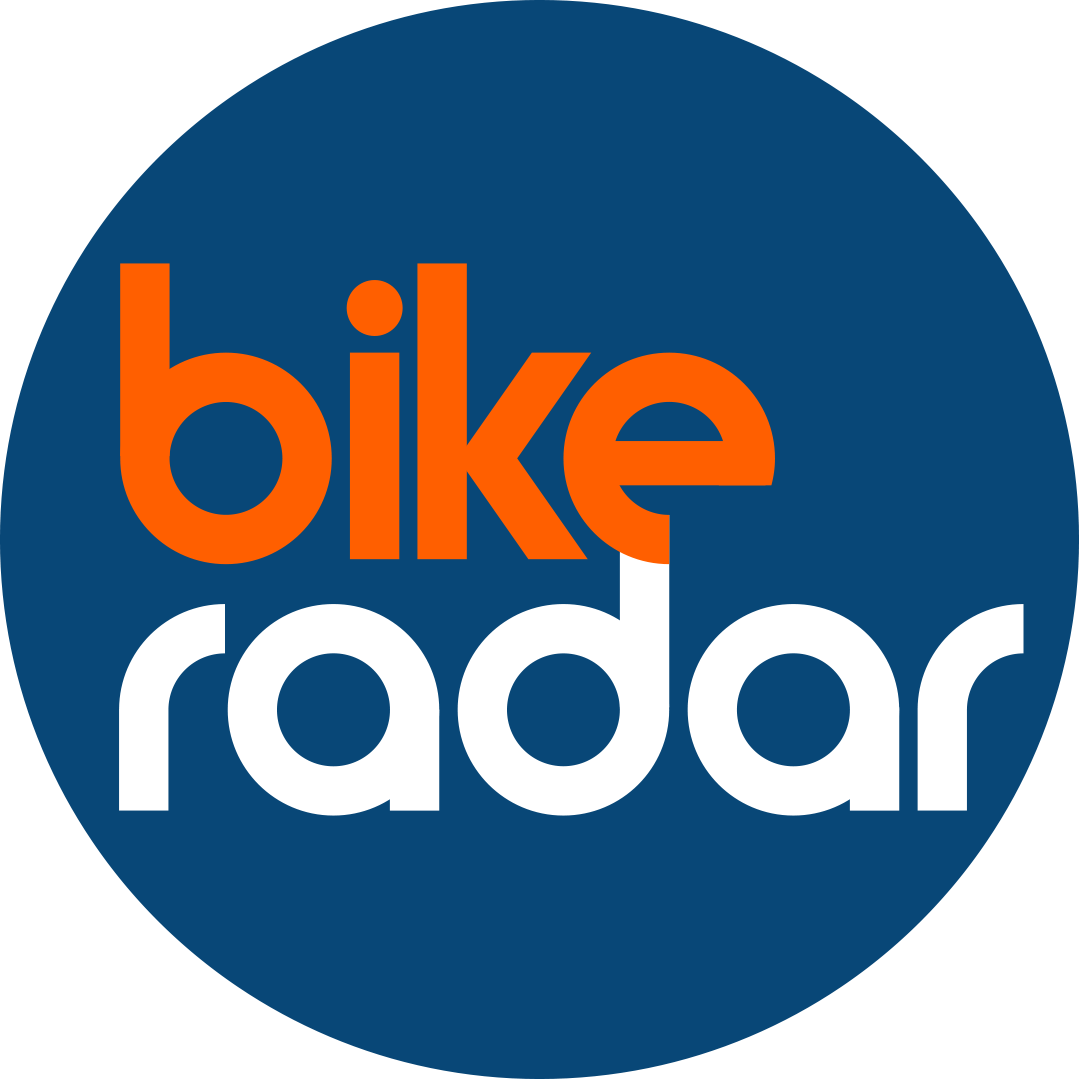Don’t let injury set you back on your cycling plans, especially if you’ve just signed up for a big event this year. Many of us are guilty of happily hammering out training sessions without giving any thought to strength and conditioning work, which can prevent injury and improve performance.
Desk jobs and sedentary lifestyles can lead to shortened muscles and poor posture, which in turn can cause our muscle output to weaken and increase the chances of overuse injuries.
Why do cyclists need strength and conditioning?
Regular strength and conditioning exercises can help you prevent the most common injuries, and you don’t need to splash out on a gym membership or expensive equipment. You can do these exercises pretty much anywhere.
For the best results, do them regularly, and gradually build up the number of sets and reps. Keep a note of these so you can track your progress and keep yourself motivated.
If you’re easily distracted, create a space and a routine you can stick to, and of course consult your doctor first if you’re in any doubt about your health.
Strength and conditioning exercises for cyclists
We’ve grouped the exercises into different categories, and they cover all the major muscle groups: quadriceps, hamstrings, calves, chest, back, shoulders, triceps, biceps, forearms, trapezius and abs.
Warm up for 10 minutes
- Prepare your body for the more strenuous movement to come
- Spend 10 minutes working through the warm-up exercises
- Don’t rush them!
Work every muscle group
- Work your way through the bodyweight exercises
- Do two to three sets
- Build the number of repetitions over time
- Do this up to three times per week on non-consecutive days
Cool down for 10 minutes
- Help your heart rate return to resting level and remove lactic acid from your muscles
- Spend up to 10 minutes working through the cool-down exercises
- Static stretches can be held for 10–30 seconds
- Breathe easily while performing all stretches — imagine breathing into the muscles themselves
- Be aware of the area being stretched and focus on relaxing those muscles
Array
Warm-up exercises
Star jumps
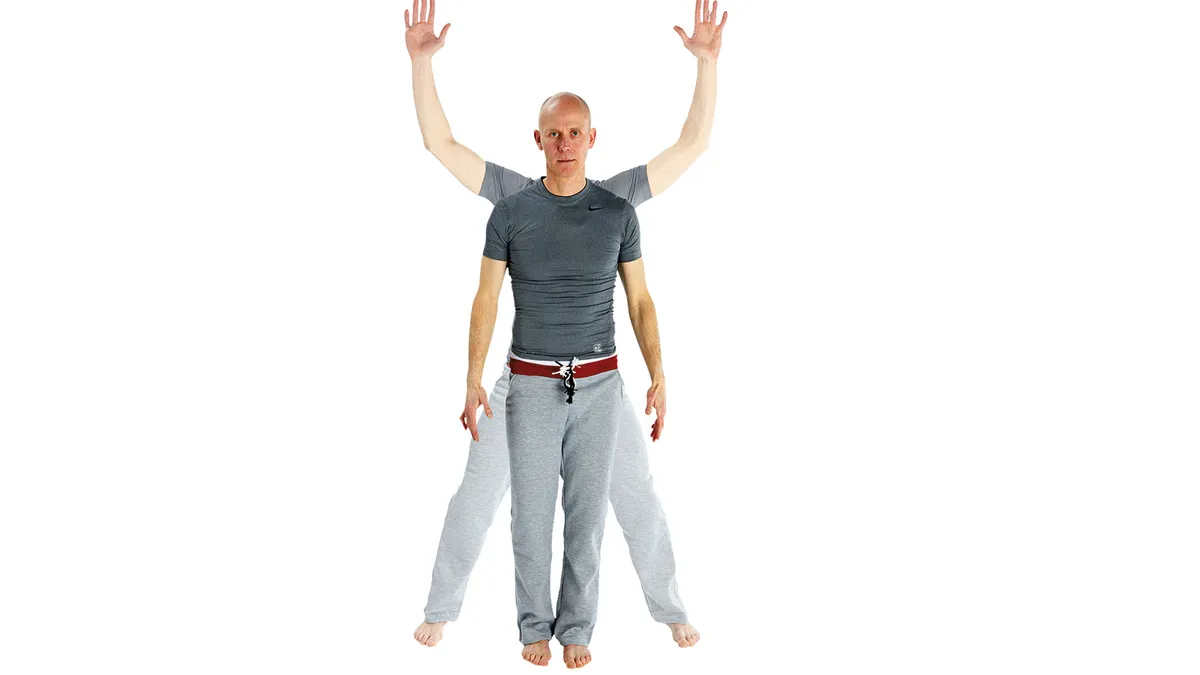
- Begin with feet together and hands by your sides
- Simultaneously jump so legs land apart and your hands are high — in an ‘X’ formation. Keep body light as you land on your toes first
- Without pause, return to starting position and do 40–60 jumps
You can include ‘split jacks’, where the legs and arms move in a forward/backward plane:
- Start with a staggered stance with left leg forward and right leg back. At the same time, left arm is back and right arm swings forward and above your shoulder
- Simultaneously jump and change arms and legs so right leg is forward and left leg is back. The arms swing back and forth at the same time
Rotations
Ankle joint
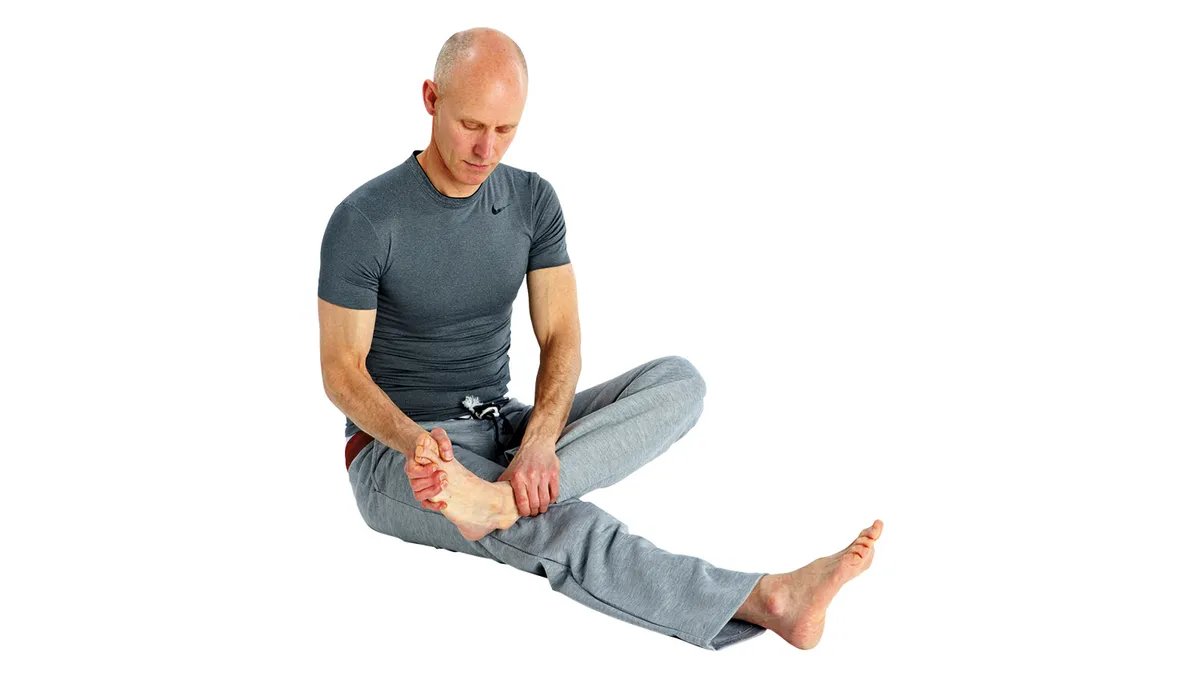
Wrists
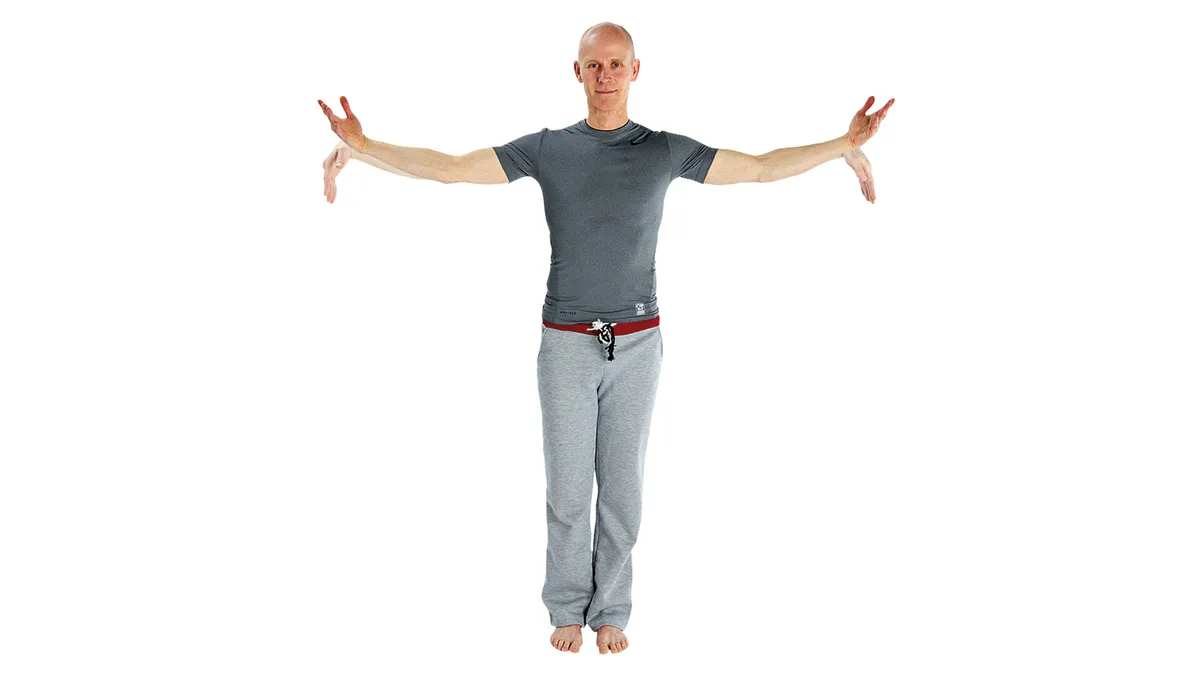
Arms
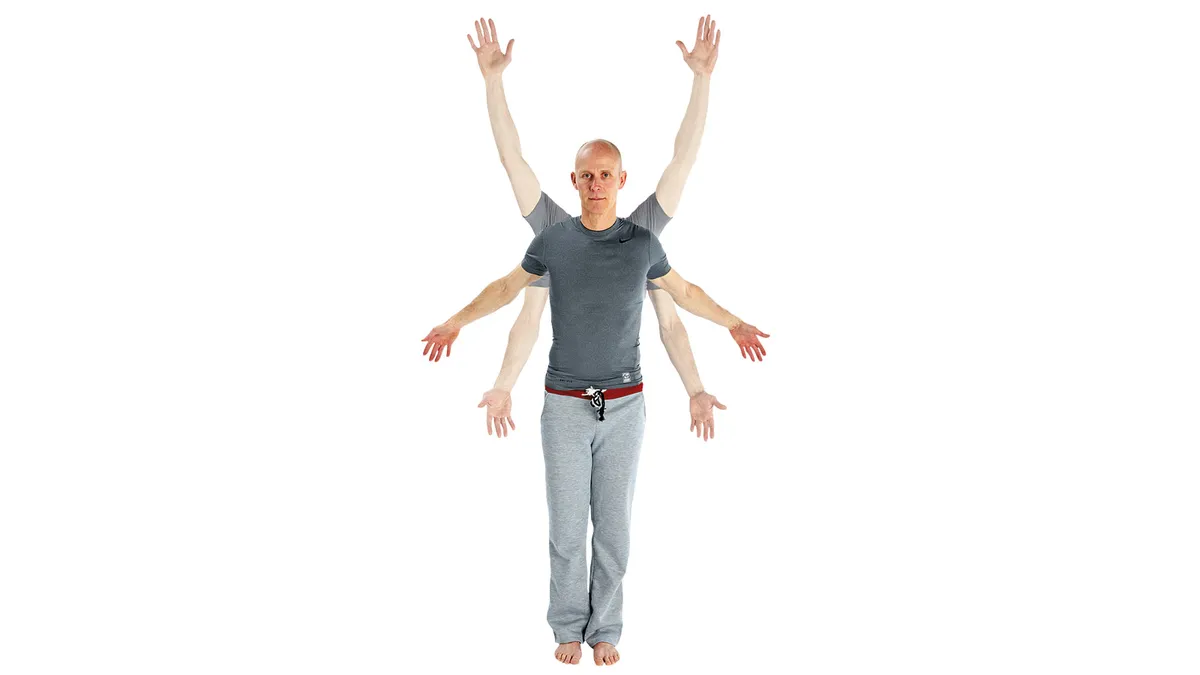
Elbows
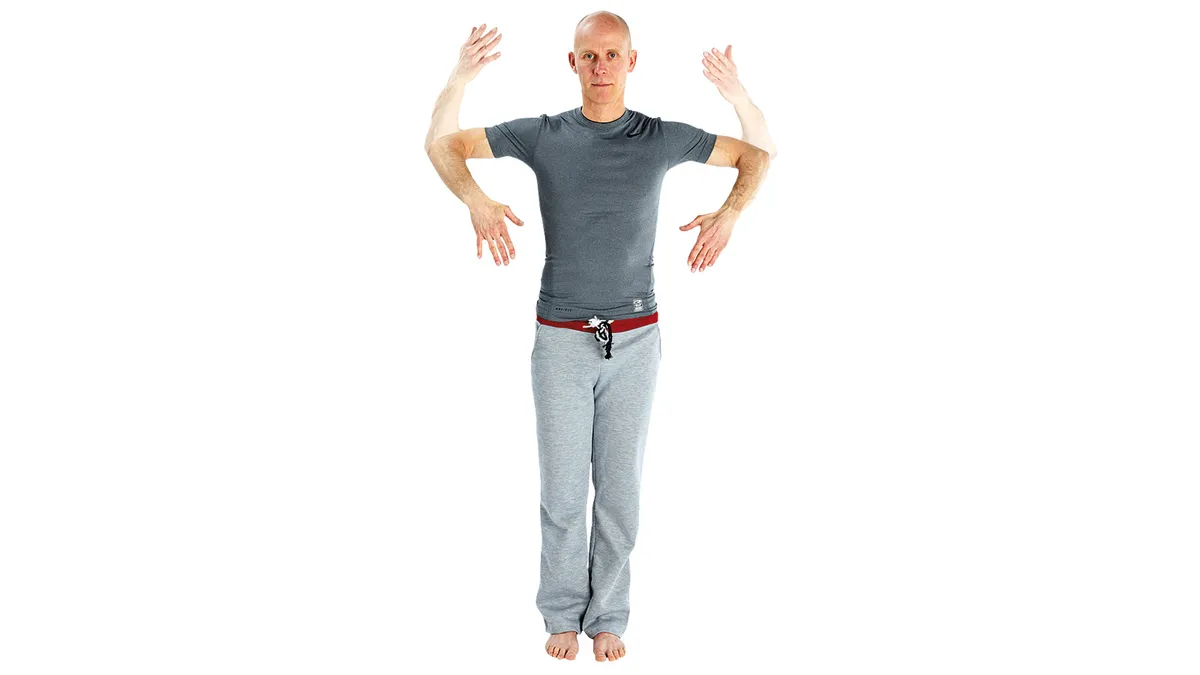
Knees
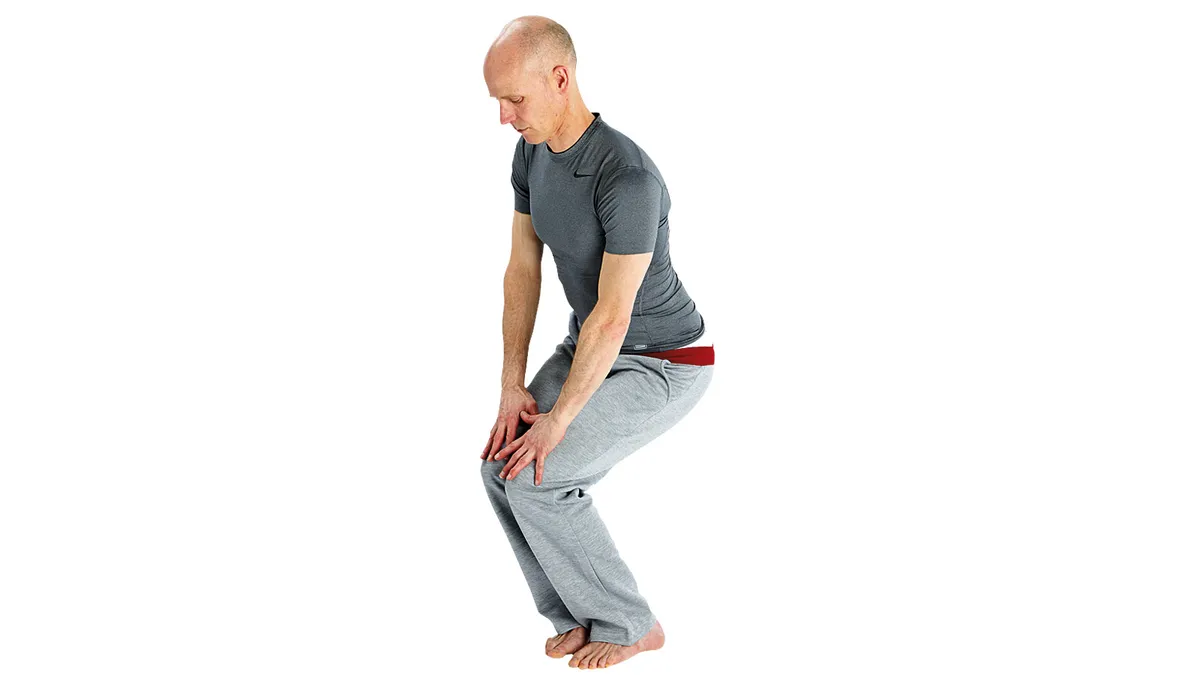
Hips

Waist
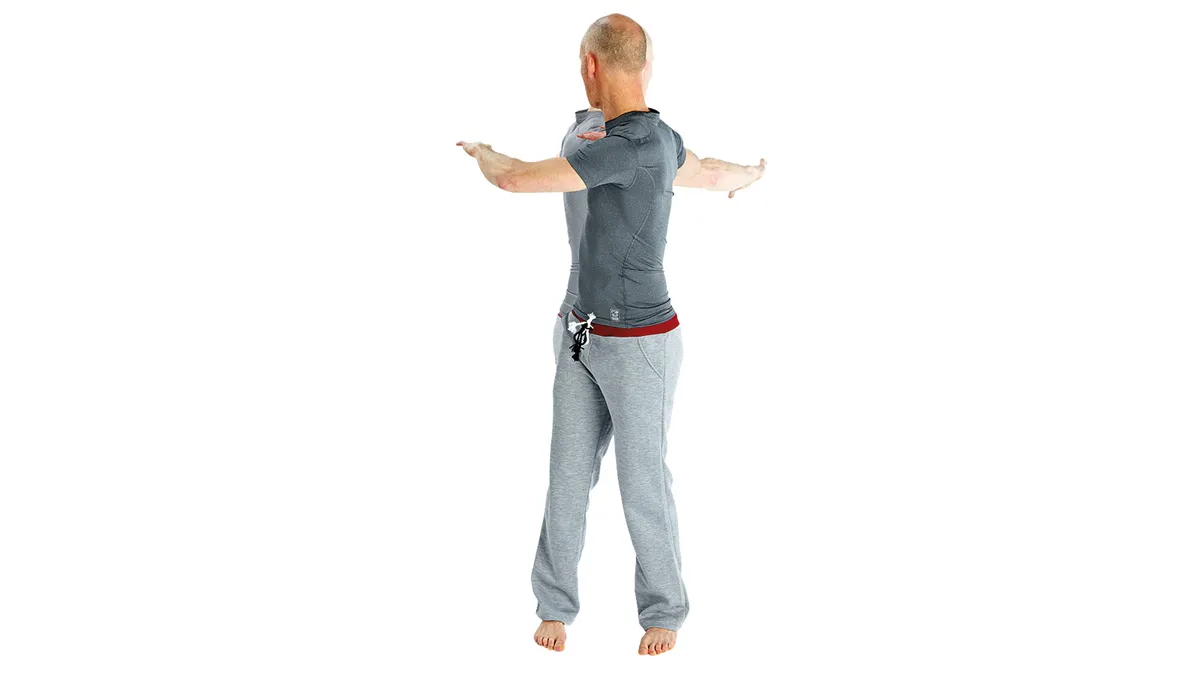
Leg swings
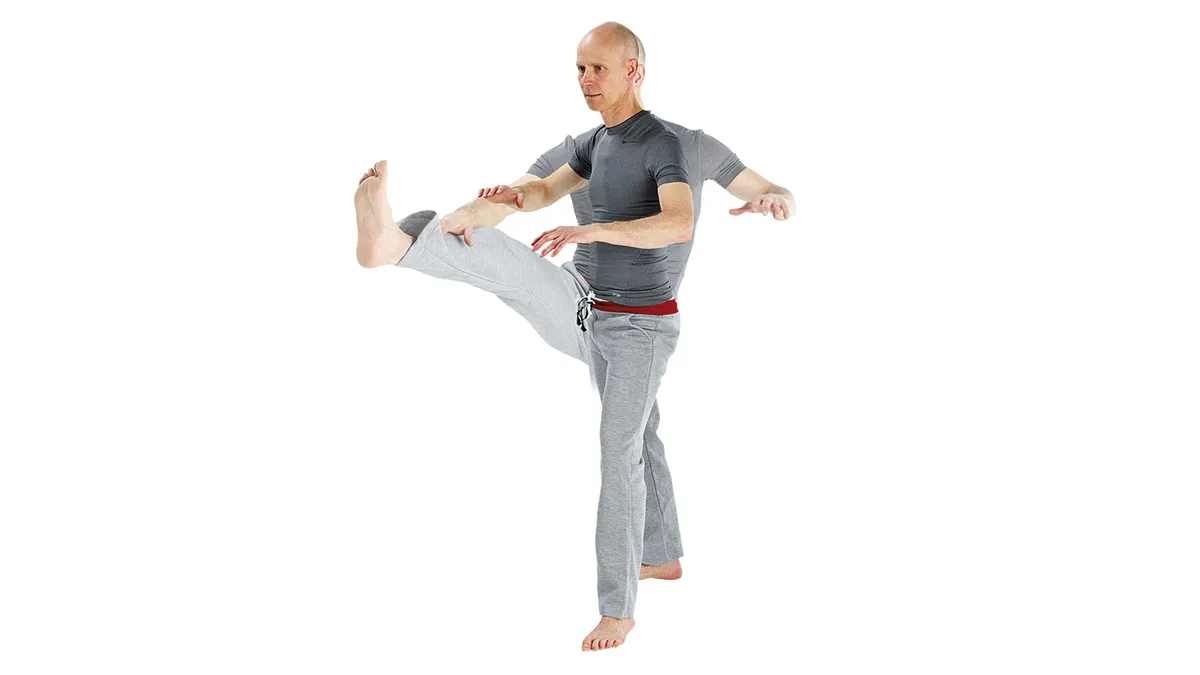
- To do leg front extensions stand sideways by a wall
- With your weight on your left leg and your right hand against the wall for balance, swing your right leg forwards and backwards
- Repetitions: 6–10 each leg
- Rest: 20 seconds
- Sets: 2
Lateral leg swings

- To perform cross-body leg flexion/abductions, place your right palm on a chair for balance and lean slightly forward with your weight on your left leg
- Swing your right leg to the left side of your body, pointing your toes upwards as your foot reaches its furthest point of motion
- Allow it to naturally return as you assist the momentum, swinging the leg across to the right as far as comfortable, again pointing your toes up as your foot reaches its final point of movement. Careful with your toes here!
Alternatively, place your palm against a wall for balance.
- Repetitions: 6–10 each leg
- Rest: 20 seconds
- Sets: 2
Coaching points
- During the leg swings, be mindful of maintaining an upright body posture. If your hips are tight, be patient and gently improve your current limit over time through regular practice
Bodyweight exercises
Jump squats
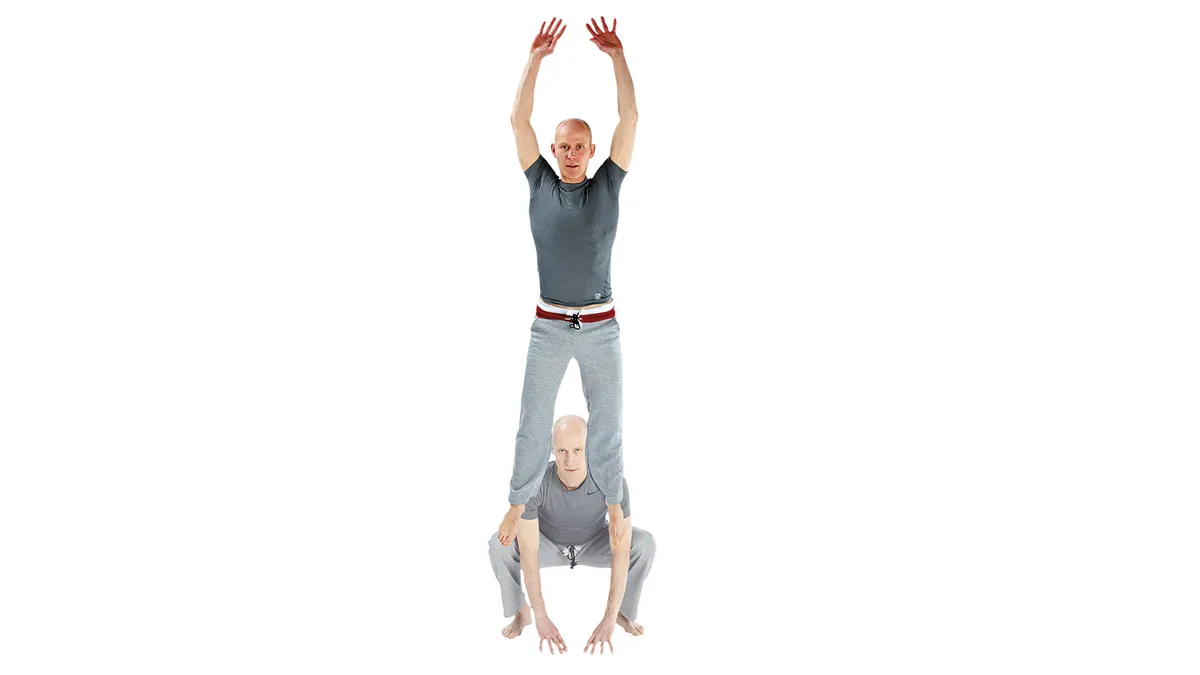
- Push your hips back and bend from the knees into a deep squat, with hands on the floor in front of the toes
- Jump upwards as high as you can go with arms reaching for the sky
- Land with both feet in the starting position
- Repetitions: 10–12
- Rest: 30 seconds
- Sets: 2–3 sets
Coaching points
- Aim to keep both toes and heels on the floor if possible in this deep squat position
- Imagine pushing the floor away from you
- Build in a 3–5 second pause to eliminate muscle elasticity. This version of the squat allows for maximum number of ‘fast twitch’ muscle fibres
Chair triceps dip
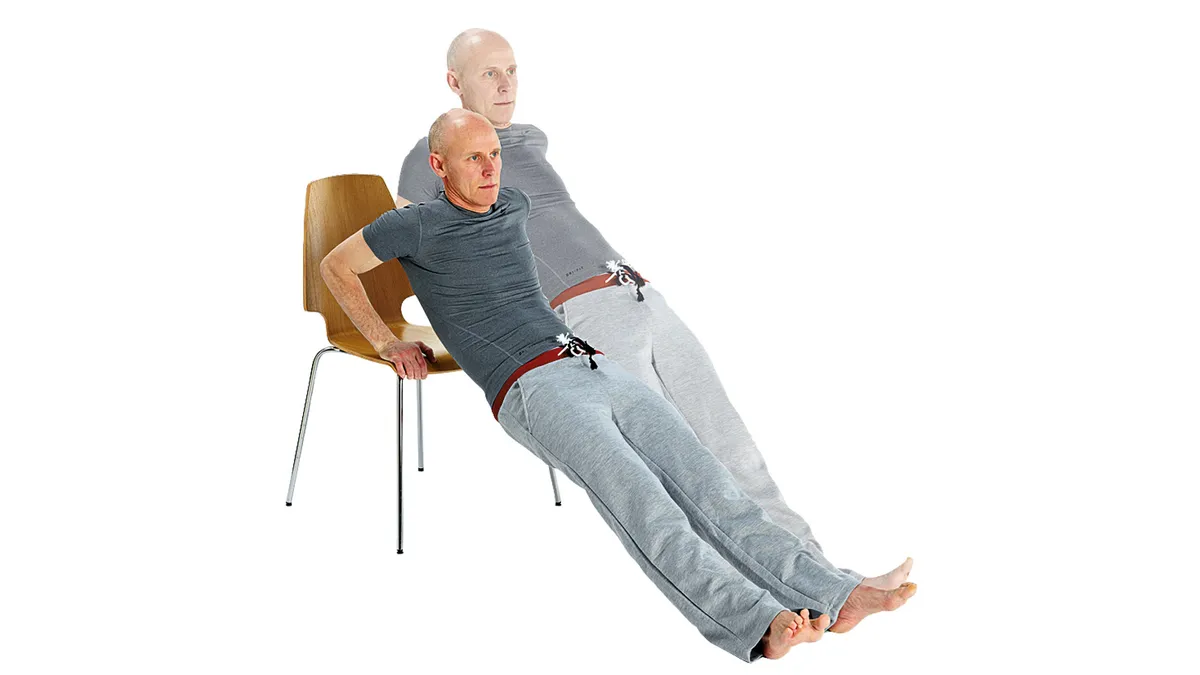
- Place your hands behind you on the edge of a chair and your feet on the floor. Keep your hips up to maintain a straight body position throughout
- Bending at the elbows, lower your body until your upper arms are nearly parallel to the floor. Pause, then press back to the start position
- Repetitions: 10–12
- Rest: 30 seconds
- Sets: 2–3
If this is too difficult, wean yourself into the exercise by starting with knees bent and feet closer to the body. This removes the core effort and allows your legs to assist the triceps.
Coaching points
- Aim to keep the body locked as straight as you can throughout the exercise. Tighten your abs and glutes while focusing on keeping the hips high
- Keep the shoulders pushed down away from the ears
- To make the exercise easier, move the feet closer toward you. To make it harder, walk the feet further way. Harder still, elevate them on another chair or bench
Mountain climbers
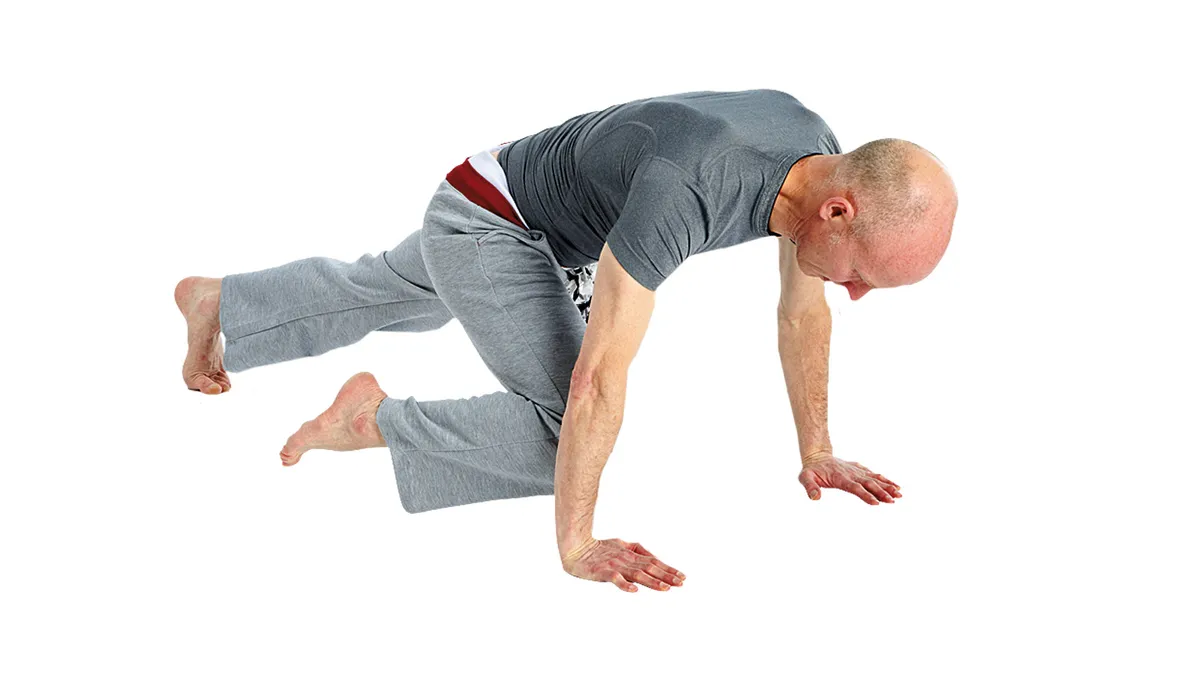
- Begin with arms locked in a slightly wider than normal press-up position
- Pump the legs alternately, starting with the right leg straight with toes on the ground while the left knee drives toward the inside of the left elbow
- Keep the legs pumping in a piston-like rhythm
- Repetitions: Build up from 30 seconds to a minute or more
- Rest: 30 seconds
- Sets: 2–3 sets
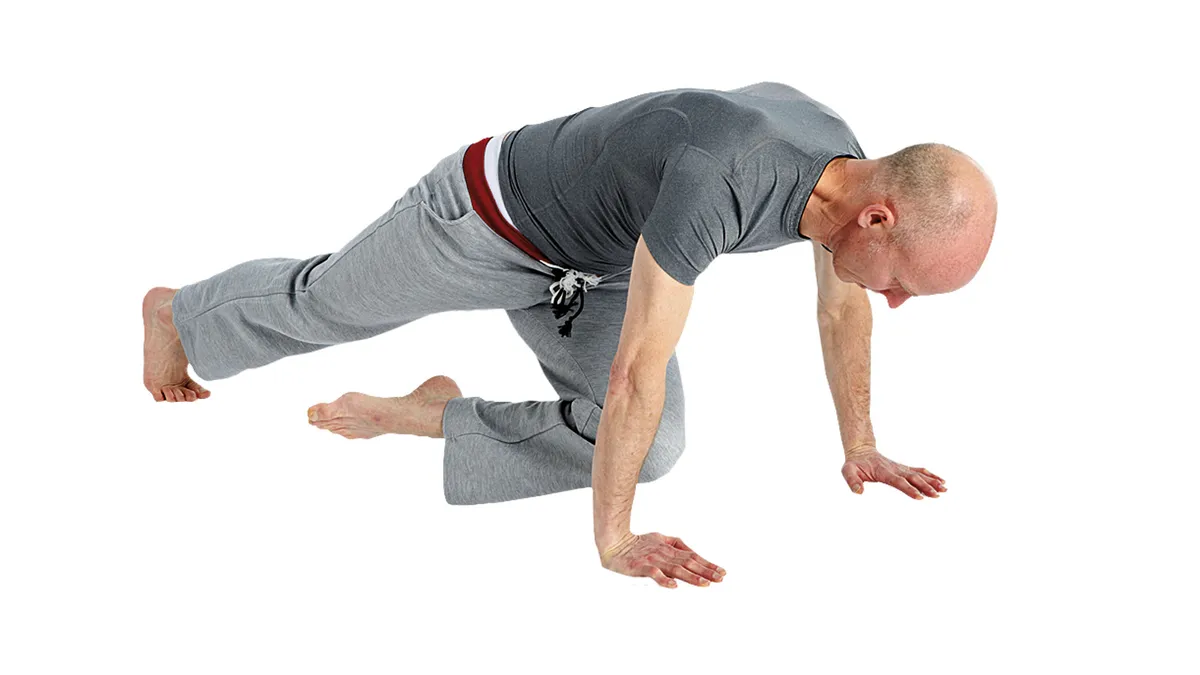
Also, use more body torsion by aiming the knee toward the elbow of the opposite arm. Feel the difference in the trunk for this variation targeting the obliques more. It challenges different ranges of motion at all the involved joints.
Coaching points
- If you have either strain or a low range of motion in the hips, perform the exercise with your hands on a bench
Shoulder bridge
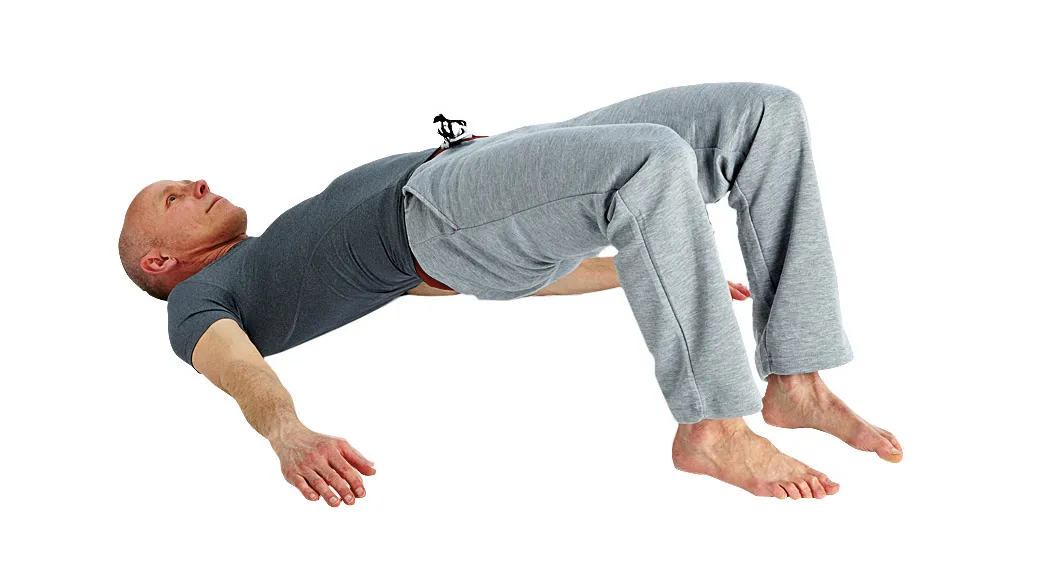
- Lie on your back with your knees bent and your feet flat on the ground
- Breathe in, squeeze the glutes and abs and raise your hips so they are in line with your knees and shoulders
- Exhale and slowly reverse back to the floor
- Repetitions: 10–12
- Rest: 30 seconds
- Sets: 2–3 sets
Take this to the next level by alternating one leg straight at a time. Also, taking the hands off the floor removes their stabilisation, therefore making the core work harder to keep balance.
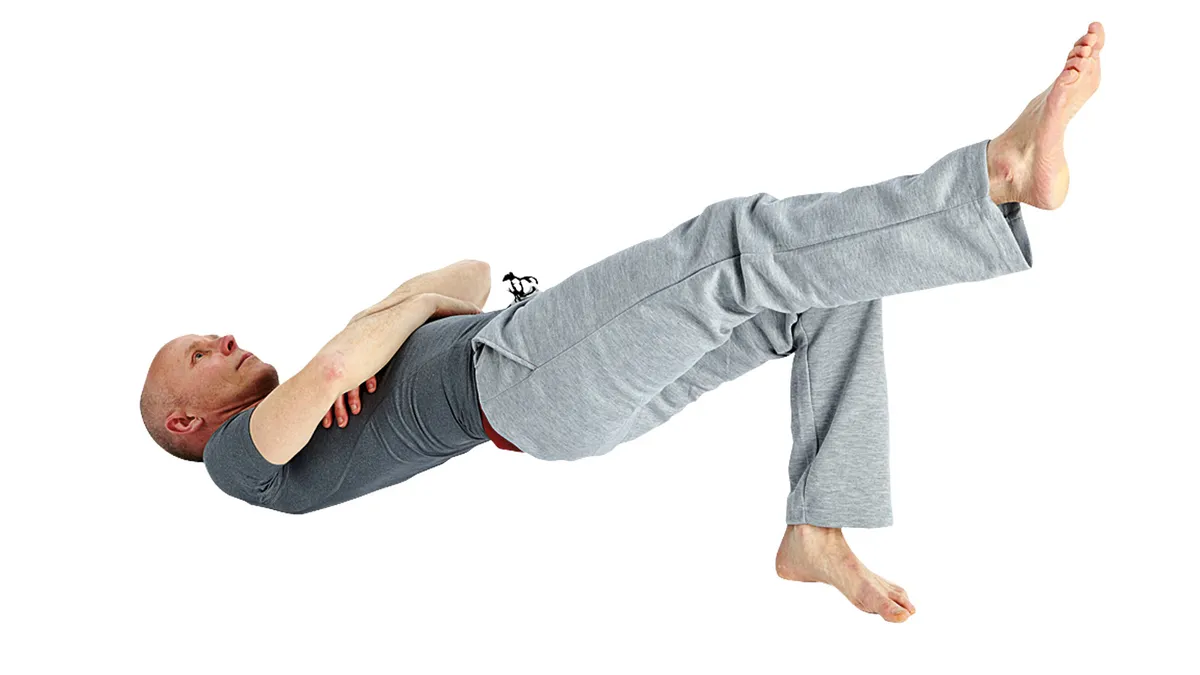
Press-ups
The classic of all bodyweight exercises, the humble press-up, is an age-old way to get into shape, targeting all the muscles of the chest as well as the shoulders, triceps and core.
When you’re comfortable with 50 regular press-ups in three minutes, up the ante. Add a few tweaks here and there to keep your training fresh.
Standard press-up
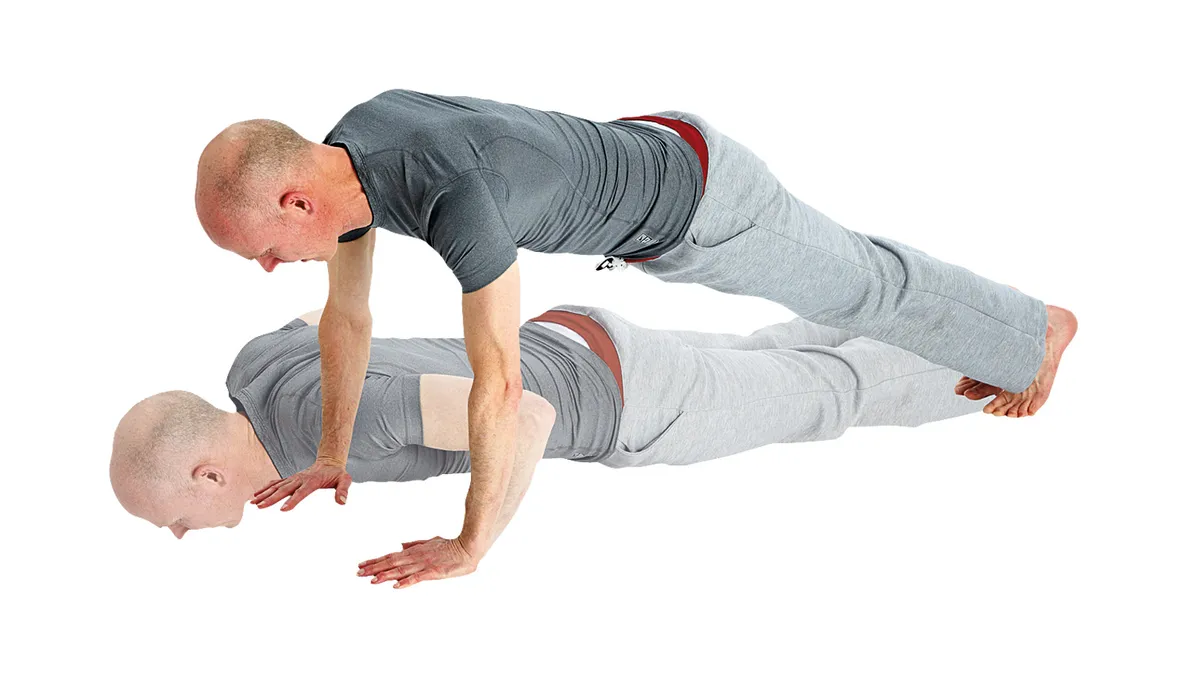
- Begin with both arms slightly wider than shoulder width. Keep them straight but not locked. Legs are straight and contact the floor with the balls of the feet
- Bend your elbows, keeping them tucked to your sides, to lower yourself down. When your chest grazes the floor, straighten your elbows to push back up to start again
Asymmetric press-up
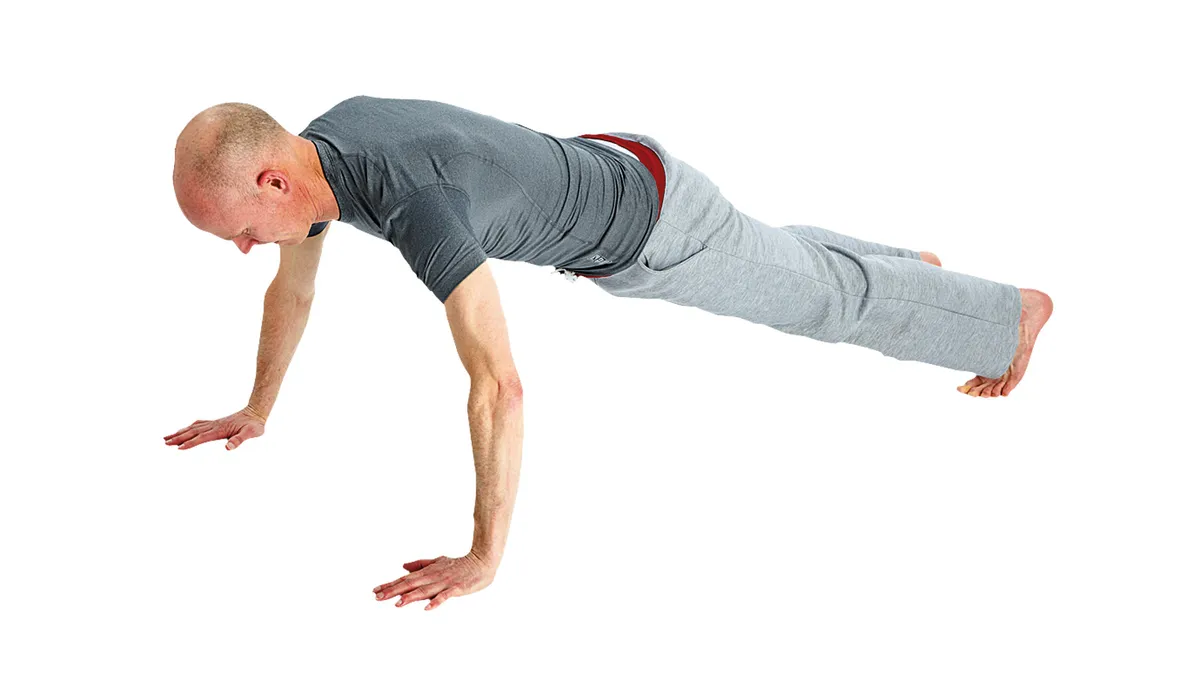
- Challenge your core stability more by moving your left arm further to the left side of your body while the right arm remains in the standard press-up position
- Mirror for the other side
Coaching points
- Focus on keeping the shoulders away from your ears
- If you find the standard press-up a challenge, pivot from your knees. Aim to wean yourself off the knees by controlling the body’s descent, focusing on full arm/glute/abs tension until your chest touches the ground. From here, pivot on your knees and push back up part way. As you near half-way, straighten your legs, returning the pivot from the knees to your feet. Gradually build up over time by lessening the distance from the ground you switch from knees to feet
- If you find the standard press-up easy, raise your legs on a block/stair to increase the weight on the shoulders
Squats
Basic squat
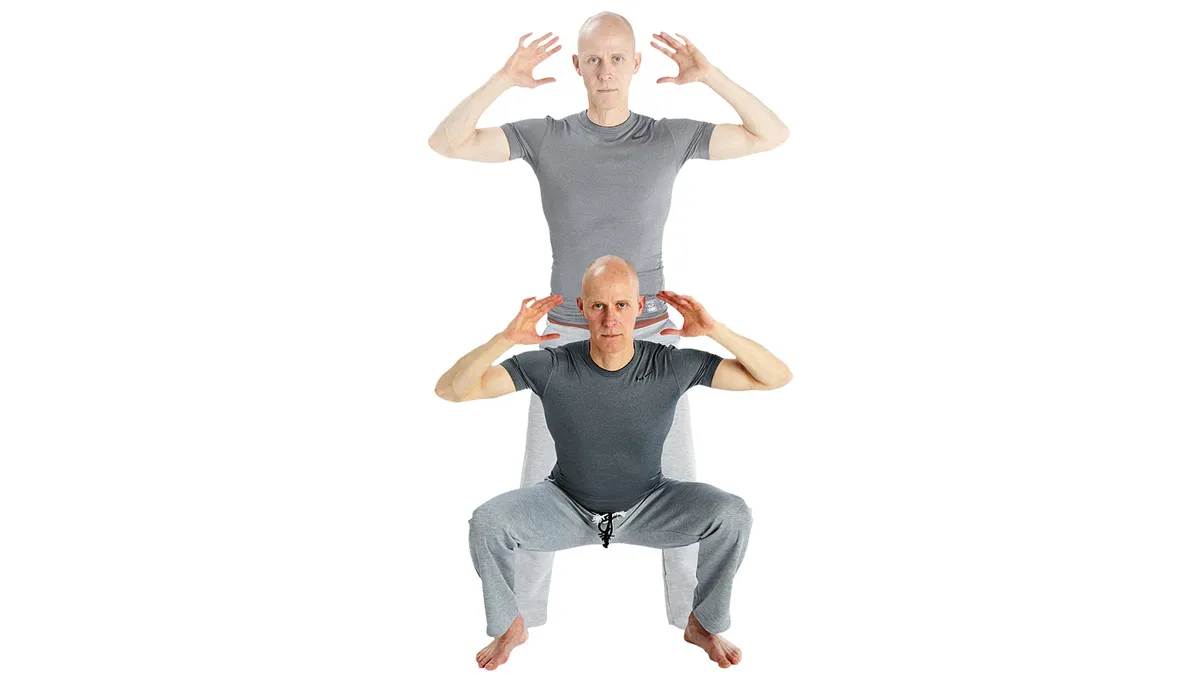
- Start in a standing position with feet slightly wider than shoulder width apart
- Gently inhale as you move your weight backwards and lower, as if sitting down
- Keeping the back straight, exhale and return to standing. Track your knees in-line with your feet throughout
- Repetitions: 10–20 or 30–60 seconds each leg
- Rest: 20 seconds
- Sets: 2–3 sets
Progress to single leg squats:
- Stand on a block, or stair, on one leg with the resting leg over the edge
- Keep the glutes tight as you bend the working leg
- Use a chair or other support for balance
Coaching points
- Make sure your knee doesn’t project beyond the toes of the front foot
- Raise the block height gradually over time
- The resting foot can be on the ball of the foot for low levels. For higher levels, place the top of the foot over the block
Bulgarian squat
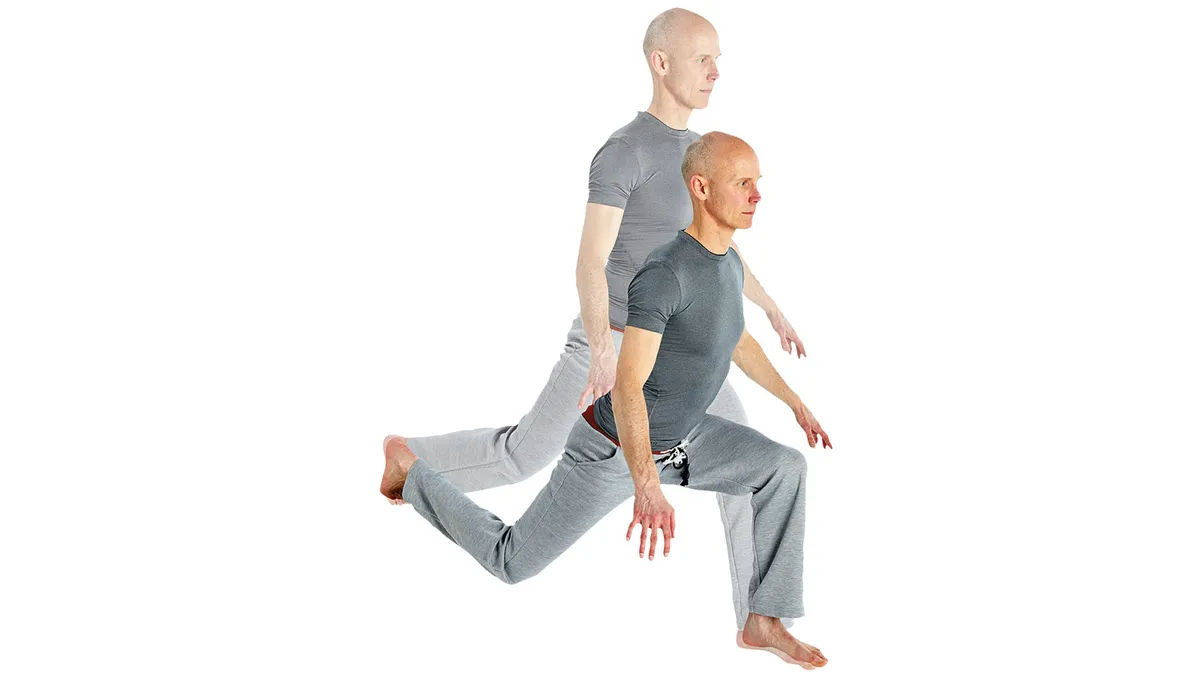
The Bulgarian squat workout activates your glutes, quads and hamstrings — an excellent lower body strength and flexibility exercise. You will need a step, low bench or coffee table for this. Make sure whichever object you pick is not too high — 15–30cm should be enough.
- Facing away from the chair or table, take a big step forward
- Reach far back with one leg and rest your foot on the edge of the elevation. Keep the heel of the front leg down and your chest up
- Squat down using the front leg, keeping the glutes active
- Return to the starting position, driving back and up from the front heel
- Repeat on the other side
- Repetitions: 10–20 or 30–60 seconds each leg
- Rest: 15 seconds
- Sets: 2–3 sets
Coaching points
- The key is to engage your glutes before starting to squat
- Focus on keeping your knee and hip aligned over your foot, and try to maintain the angle of your knee with your foot. Using a mirror may help you monitor this
- Make sure you push your weight backward towards the heels before sitting into the squat — squatting into a wall or having someone’s hand in front of your knee will help
- Imagine you are being pulled up from the crown when returning to the standing position
- Make sure you maintain a tall back and a good posture throughout
- Take advantage of the 15-second rest time to perform light star jump routines. Stretching legs in between the Bulgarian squat sets promotes healthy blood flow and prevents cramps and early leg fatigue
Lunges
Basic lunge
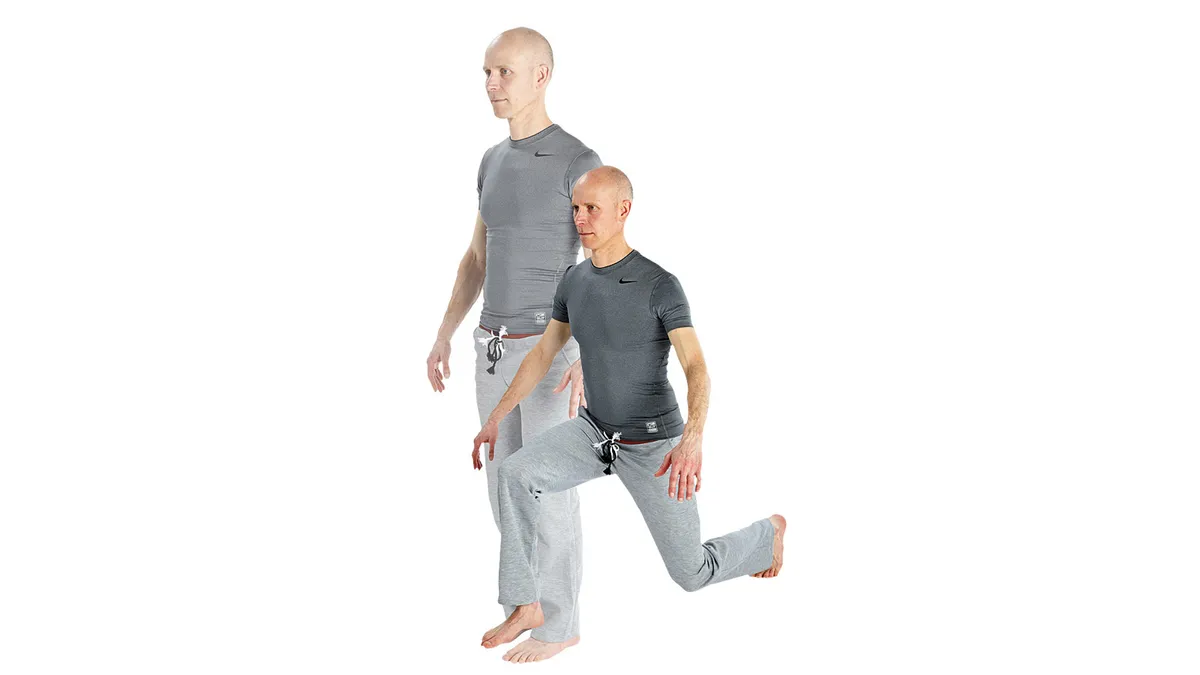
- From a standing position, step forward with your right leg until your knee is bent at 90 degrees
- Quickly push yourself back to the starting position. Work with the same leg for the desired time/reps then change legs for the same amount
- Repetitions: 10–12 each leg
- Rest: 30 seconds
- Sets: 2–3 sets
Variation: Step backwards until your rear knee almost touches the floor. Add further benefit by twisting the body to one side as you enter the lunge position. This can be done holding a ball or weight if desired.
Coaching points
- Make sure your knees don’t project beyond your toes on the forward leg
- Your rear knee should nearly touch the floor
- Mix up your training patterns by alternating legs for double the time on the stepping lunges
- Keep your body upright during all the lunge movements
Jumping lunges
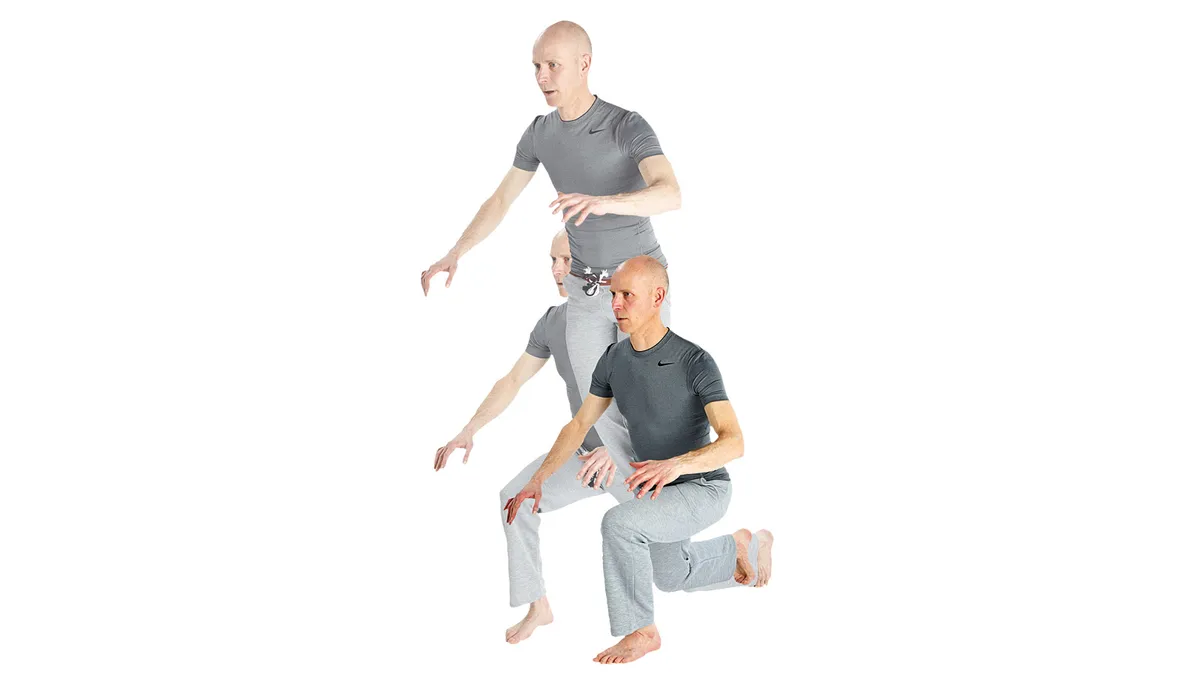
- Begin from standing with feet shoulder-width apart
- Jump up and land in the lunge position, then immediately spring up off the ground, again switching feet position in mid-air
- Land softly and keep going
Coaching points
- Jumping lunges should only be performed with perfect technique. If you’ve any doubt about your technique when performing standard lunges, it would be best to leave jumping lunges for another day
- Bend your knees to absorb the impact on landing and focus on keeping your feet and knees facing straight forward
Jack-knife crunches
Jack-knifes are much more functional and beat ineffective sit-ups any day
Level 1
- Lie flat on your back with your legs straight and your arms extended past your head
- Allow your legs to bend as you slowly bring both knees toward your body, simultaneously raising your upper body and bringing your straight arms either side of the knees.
Level 2
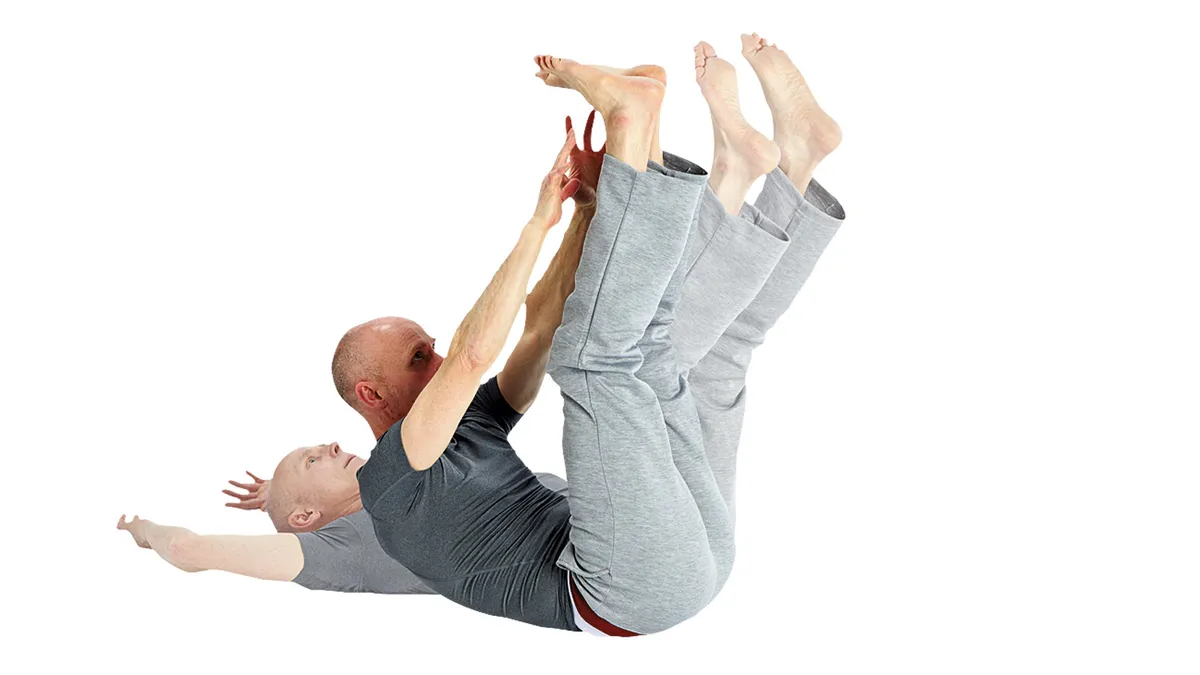
- Tighten your abs and slowly bring your legs and arms up at the same time until your body forms a V
- Try to touch your feet without bending your legs
- Hold for a second, then slowly return to the starting position
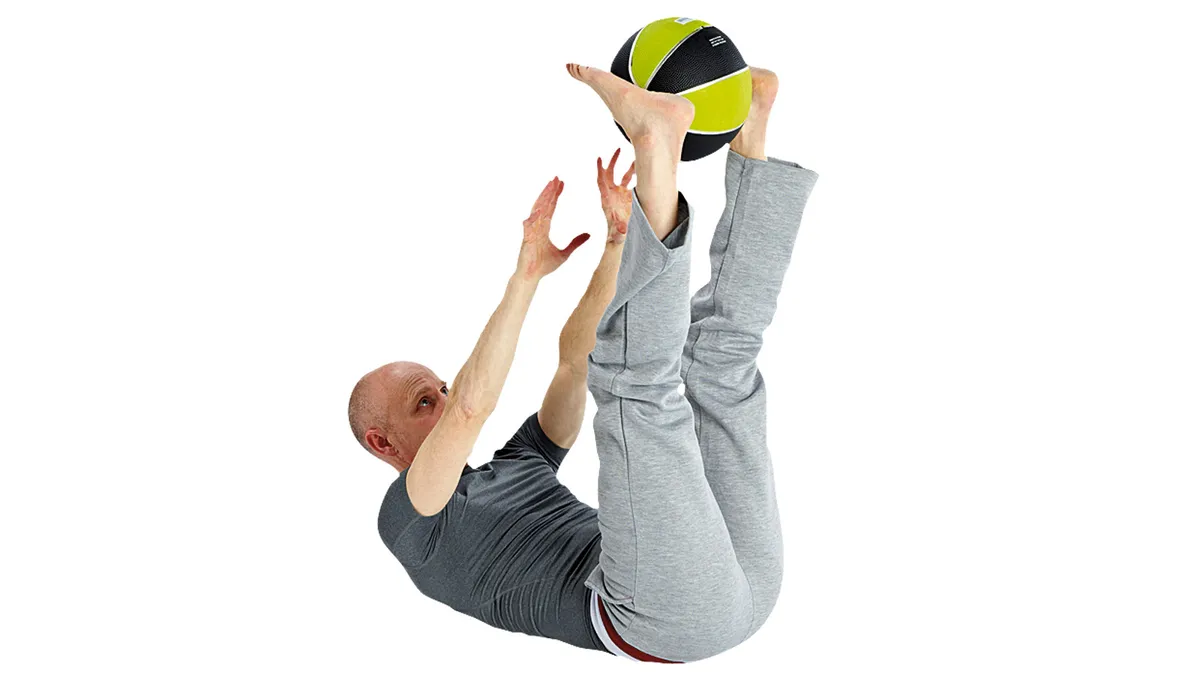
- Repetitions: 10–15
- Rest: 30 seconds
- Sets: 2–3 sets
Cool-down stretches
Quad stretch
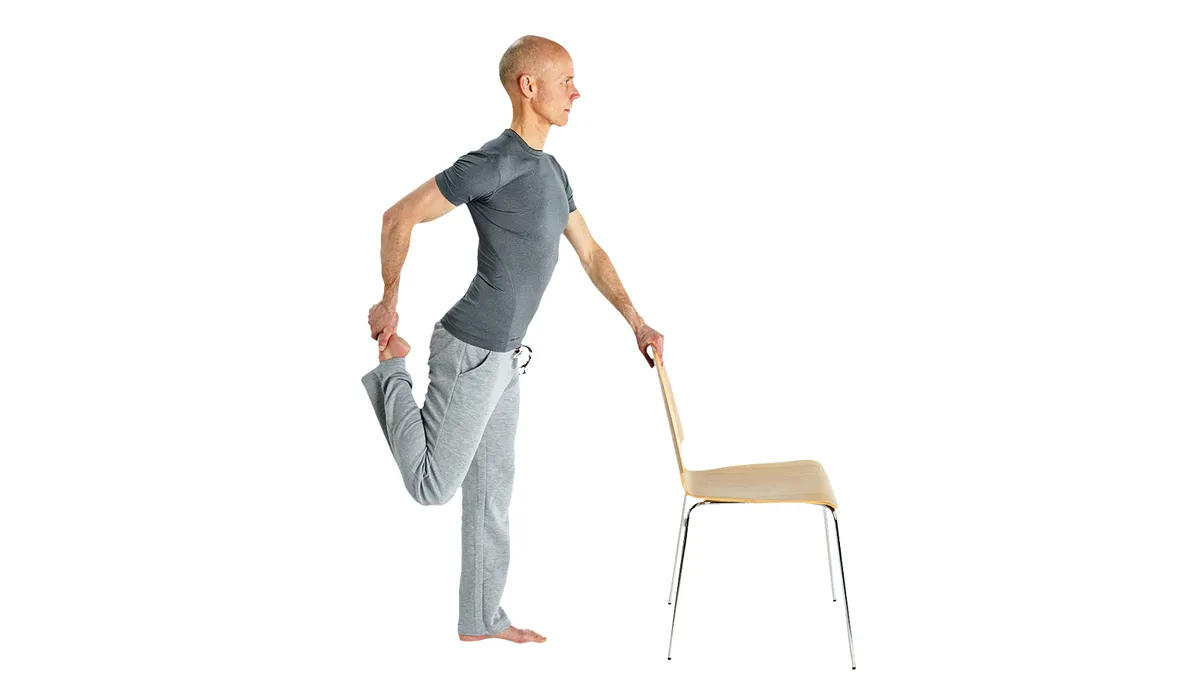
- Stand on your left leg, then bend the right leg and take hold of your foot in your right hand
- Gently pull your heel towards the centre of your right buttock. Keep your body upright
- If your body allows, try to raise your leg higher, without compromising your upright body posture.
Hip flexor
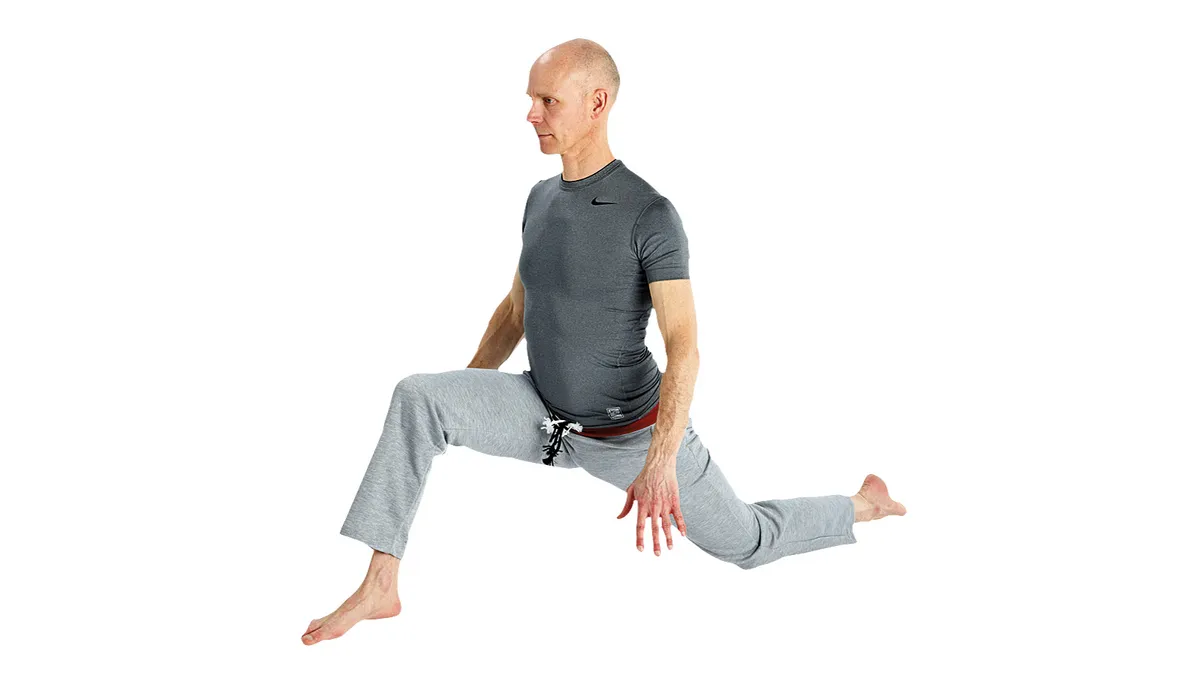
- Take a long step forward and allow the instep of the rear foot to contact the floor
- Aim to keep alignment between the rear heel, knee and glute
- Keep your hips and shoulders square to the front
- Work your front foot forward until you feel a stretch in the front of the hip on your trailing leg
- Squeeze the glutes and gently push your rear knee into the floor
- After a while, relax while breathing out and allow the deeper stretch. Make sure your knee doesn’t project beyond the toes of the front leg
Cobra stretch
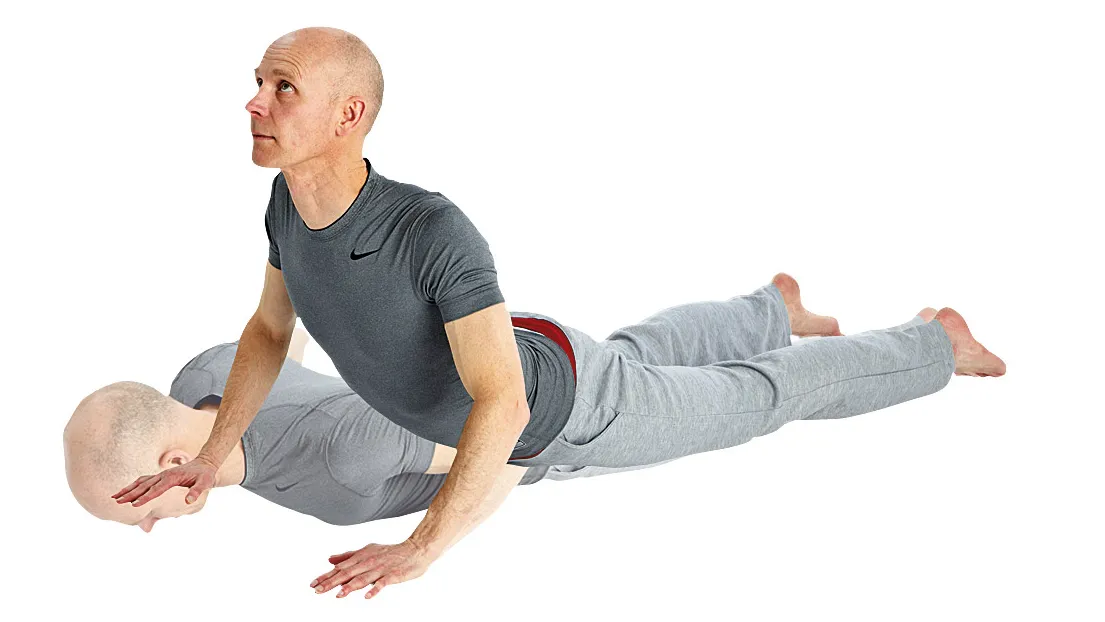
- Lie on your front on the floor and bring your hands under the shoulders
- Keeping your legs and hips on the ground, push your upper body up off the floor. You should feel a pressure on your lower back
- Go deeper by holding your head back looking at the ceiling. Don’t pull you head back too much to avoid any pressure on the back of the neck
- Breathe deeply and aim to hold for 20–30 seconds
- Repeat a second time
Calf stretch
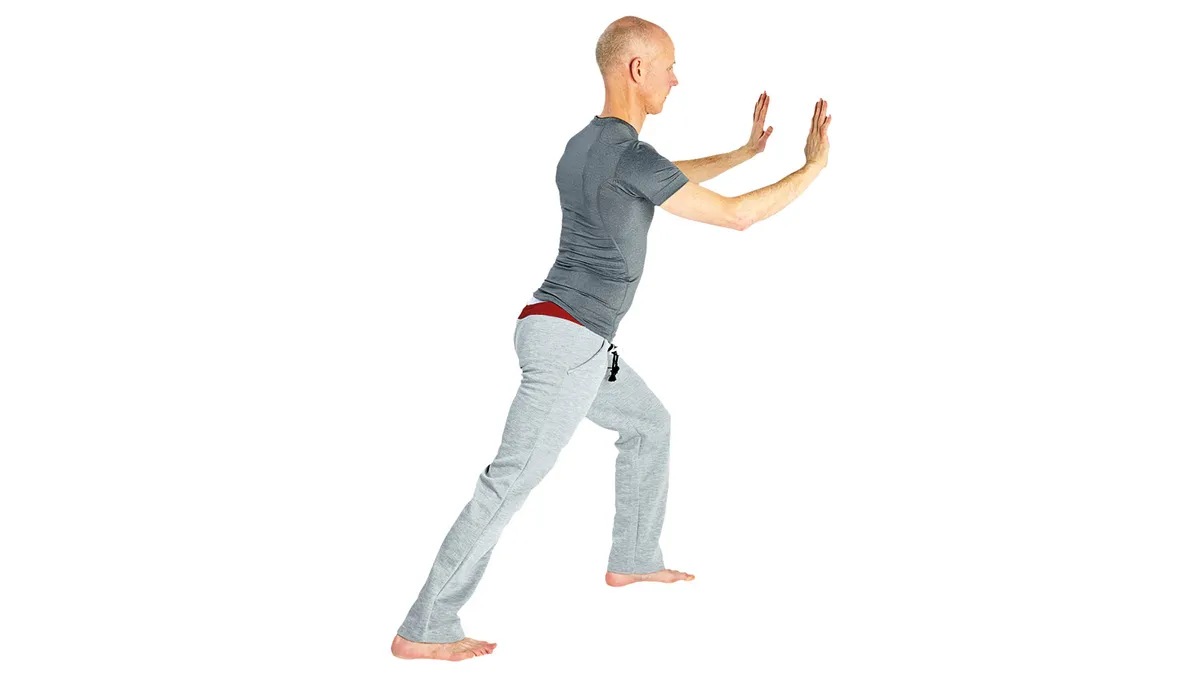
- Stand with both palms against a wall and toes of your front foot a few inches away
- Step back on the other leg, keeping it straight with the heel planted firmly into the ground
- Keep your spine erect and push from your hands into the heel of the rear foot. You should feel the stretch in your upper calf in the rear leg
Soleus stretch
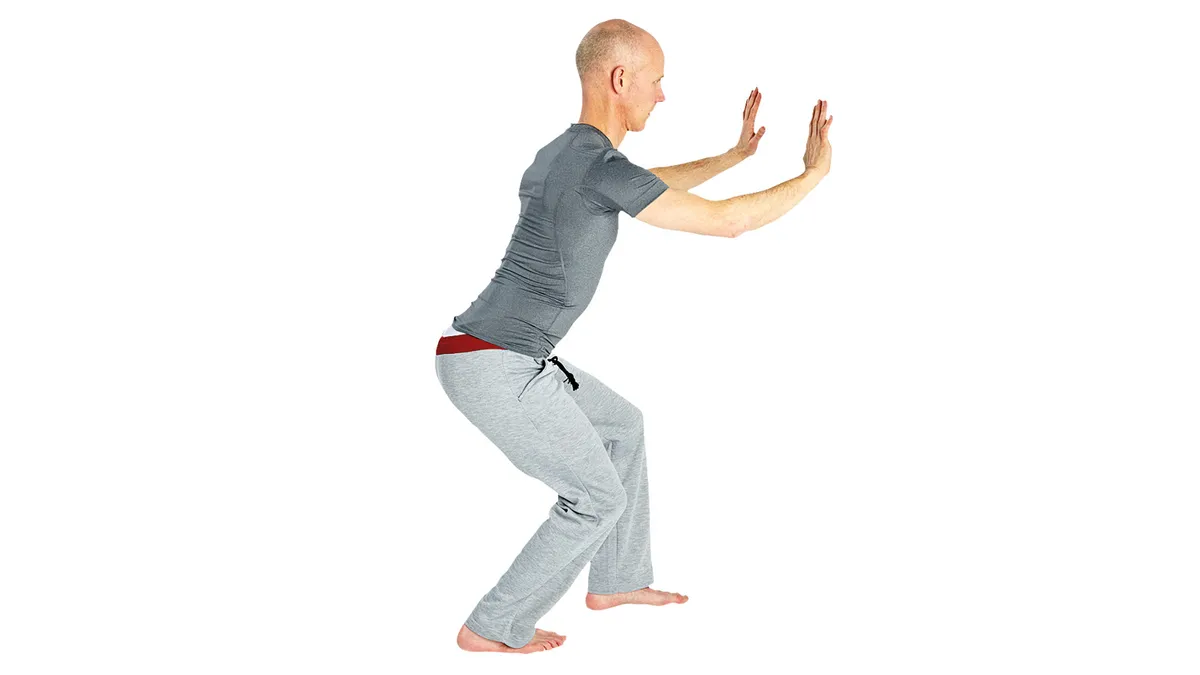
- Start in the same position as the calf stretch above
- Bring your rear foot forward to about 30cm from the front foot
- Bend both knees and sink your body down with more weight on the rear foot. You should also feel benefit in foot/ankle flexibility
Good morning stretch
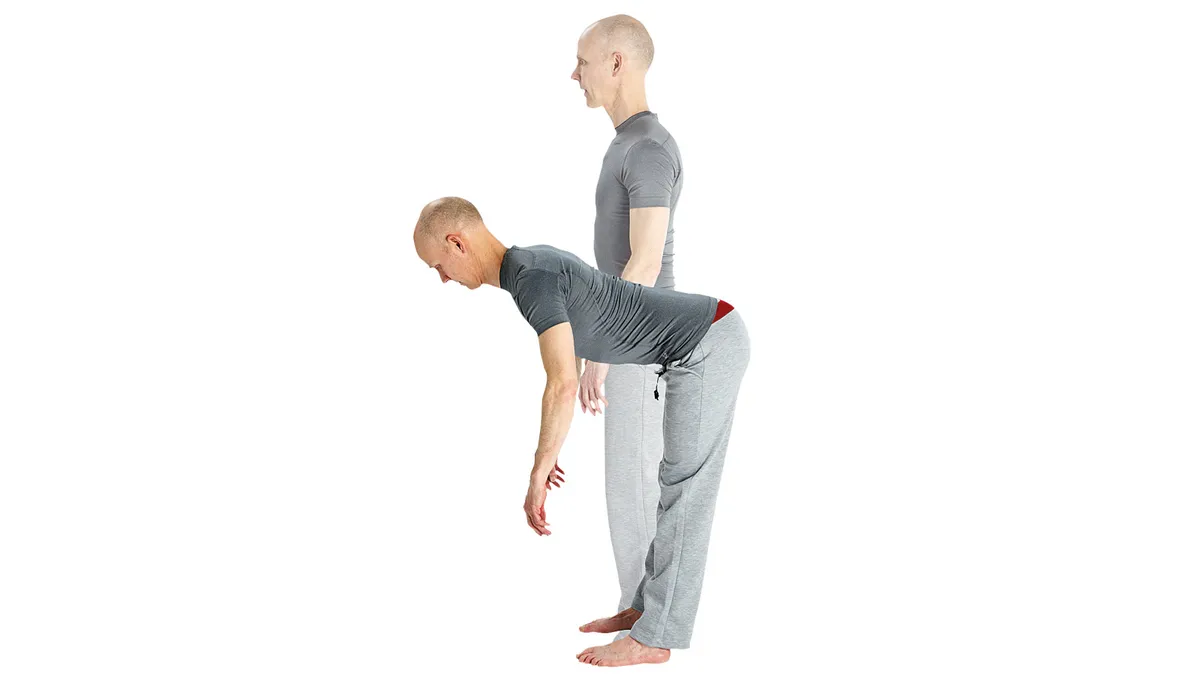
- Keep the back flat throughout and aim to ‘fold’ at the front of the hip (not the back)
- Push your weight onto your heels
- Breathe in then, while breathing out, slowly lower your upper body towards the ground
- Pause to breathe in again, before going further, if your body allows
- Be aware of posture here. Remember, the aim is for a deep stretch down the rear legs, not how close your hands go to the floor
Updated 17 January 2019
